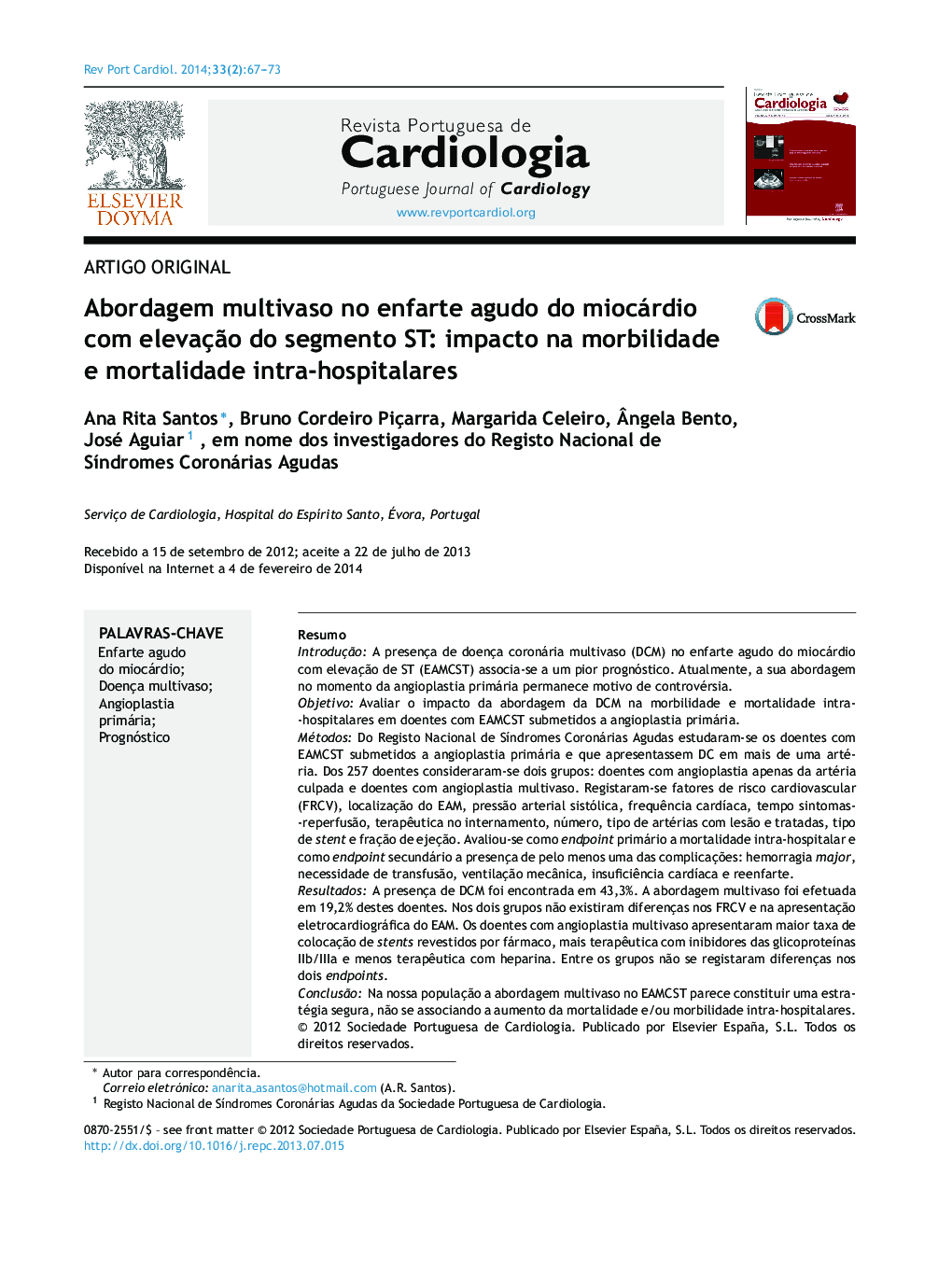| Article ID | Journal | Published Year | Pages | File Type |
|---|---|---|---|---|
| 1126259 | Revista Portuguesa de Cardiologia | 2014 | 7 Pages |
ResumoIntroduçãoA presença de doença coronária multivaso (DCM) no enfarte agudo do miocárdio com elevação de ST (EAMCST) associa‐se a um pior prognóstico. Atualmente, a sua abordagem no momento da angioplastia primária permanece motivo de controvérsia.ObjetivoAvaliar o impacto da abordagem da DCM na morbilidade e mortalidade intra‐hospitalares em doentes com EAMCST submetidos a angioplastia primária.MétodosDo Registo Nacional de Síndromes Coronárias Agudas estudaram‐se os doentes com EAMCST submetidos a angioplastia primária e que apresentassem DC em mais de uma artéria. Dos 257 doentes consideraram‐se dois grupos: doentes com angioplastia apenas da artéria culpada e doentes com angioplastia multivaso. Registaram‐se fatores de risco cardiovascular (FRCV), localização do EAM, pressão arterial sistólica, frequência cardíaca, tempo sintomas‐reperfusão, terapêutica no internamento, número, tipo de artérias com lesão e tratadas, tipo de stent e fração de ejeção. Avaliou‐se como endpoint primário a mortalidade intra‐hospitalar e como endpoint secundário a presença de pelo menos uma das complicações: hemorragia major, necessidade de transfusão, ventilação mecânica, insuficiência cardíaca e reenfarte.ResultadosA presença de DCM foi encontrada em 43,3%. A abordagem multivaso foi efetuada em 19,2% destes doentes. Nos dois grupos não existiram diferenças nos FRCV e na apresentação eletrocardiográfica do EAM. Os doentes com angioplastia multivaso apresentaram maior taxa de colocação de stents revestidos por fármaco, mais terapêutica com inibidores das glicoproteínas IIb/IIIa e menos terapêutica com heparina. Entre os grupos não se registaram diferenças nos dois endpoints.ConclusãoNa nossa população a abordagem multivaso no EAMCST parece constituir uma estratégia segura, não se associando a aumento da mortalidade e/ou morbilidade intra‐hospitalares.
IntroductionMultivessel disease in ST‐elevation myocardial infarction (STEMI) is associated with a worse prognosis. A multivessel approach at the time of primary percutaneous coronary intervention (PCI) is the subject of debate.ObjectiveTo assess the impact of a multivessel approach on in‐hospital morbidity and mortality in patients with STEMI undergoing primary PCI.MethodsWe studied patients from the Portuguese Registry of Acute Coronary Syndromes with STEMI and multivessel disease who underwent primary PCI. The 257 patients were divided into two groups: those who underwent PCI of the culprit artery only and those who underwent multivessel PCI. Cardiovascular risk factors, STEMI location, in‐hospital treatment, number and type of diseased and treated arteries, type of stent implanted and ejection fraction were recorded. The primary end‐point was defined as in‐hospital mortality and the secondary end‐point as the presence of at least one of the following complications: major bleeding, need for transfusion, invasive ventilation, heart failure and reinfarction.ResultsMultivessel disease was found in 43.3% of the study population and a multivessel approach was adopted in 19.2% of these patients. There were no differences between the groups in cardiovascular risk factors or electrocardiographic presentation of STEMI. Patients undergoing multivessel PCI were more likely to be treated with drug‐eluting stents and glycoprotein IIb/IIIa inhibitors, and less likely to receive heparin therapy. There were no differences between the groups with regard to in‐hospital mortality or the incidence of complications.ConclusionIn our population of patients with STEMI, a multivessel approach appears to be safe and not associated with increased in‐hospital mortality or morbidity.
